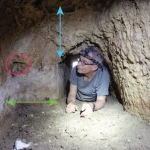Although this unusual event is being studied for decades, it is still unclear whether the deposition of a million cubic kilometers of salts was triggered by a large drop in sea level, on the order of thousands of meters, or if it occurred in a deep sea that remained connected to the Atlantic Ocean.
A recent paper published in Nature Communications and co-authored by two researchers from the GSI (Gvirtsman and Gavrieli), in collaboration with experts from Europe, examines the isotopic composition of chlorine in the salts to study the environment in which it was deposited.
The researchers identified two distinct deposition phases. During the first phase, which lasted about 35,000 years, the connection with the Atlantic Ocean was maintained, the Mediterranean Sea level remained high, but the outflow of water to the Atlantic Ocean was limited; during this period, salt was deposited only in the eastern Mediterranean. In the second phase, which lasted less than ten thousand years, the Mediterranean was completely disconnected from the Atlantic Ocean, and salt was deposited on its seafloor driven by a sharp drop in sea level, which reached about 2 kilometers in the eastern part and about 0.85 kilometers in the western part. It is important to note that even at the peak of this huge sea-level drop, the Rodotos Basin and the Ionian Basin still had deep water of over a thousand meters.
Chlorine isotopes constrain a major drawdown of the Mediterranean Sea during the Messinian Salinity Crisis





























